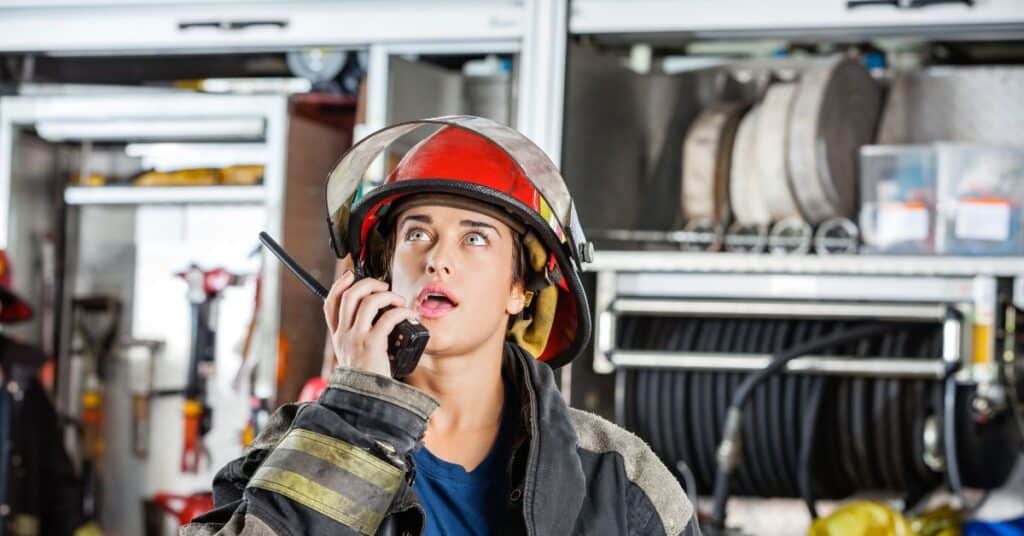Walkie-talkies are important tools used in places like security, such as emergencies, building things, and outdoor fun. But sometimes, they need help like signals getting mixed up, batteries running out fast, or unclear sounds. In this blog, we learn to fix these problems easily. We’ll talk about walkie talkie troubleshooting, how to make the signals clearer, make the batteries last longer, and fix the sound so it’s better. If you understand and try these fixes, your walkie-talkies will work well whenever needed. Whether hiking or working on a building site, you can count on your walkie-talkies to help you talk clearly without any interruptions.

Contents
Understanding Common Walkie-Talkie Issues
Signal Interference:
Signal interference happens when other devices or signals mess up the talk between walkie-talkies. It can happen because of buildings, trees, or other electronics nearby. To fix this, you try changing the channel or moving to a different spot with fewer obstacles. Sometimes, turning off nearby electronic devices helps.
Battery Drainage:
Battery drainage happens when walkie-talkie batteries lose power too fast. This can happen because the batteries are old, the walkie-talkie stays on when you’re not using it, or you’re using high-power settings. To stop battery drainage, use new batteries, turn off the walkie-talkie when you’re not using it, and use lower power settings.
Audio Distortion:
Audio distortion makes it hard to hear or understand the messages from walkie-talkies. This can happen because of problems with the microphone, speaker, or volume settings. To fix audio distortion, check if the microphone and speaker are clean and properly connected. Changing the volume settings also helps make the sound better.
Range Limitations:
Range limitations mean the farthest distance walkie-talkies can talk to each other well. Things like land, obstacles, and how powerful the walkie-talkies are can change their range. To talk from farther away, try lifting the walkie-talkie, moving things in the way, or using more powerful devices.
Physical Damage:
Physical damage happens when walkie-talkies get dropped, hit, or are in tough places. This can make the walkie-talkie break or not work right. To stop physical damage, be careful with walkie-talkies, use covers to protect them, and try not to put them in hard places. Checking them often can help find problems early and fix them before they worsen.
Walkie Talkie Troubleshooting Solutions

Signal Interference
1. Adjusting channels and frequencies: Try changing the channels and frequencies on your walkie-talkie to clarify the signal. Test different settings until you find one that works better.
2. Identifying sources of interference: Look around to see if any electronics or things are blocking the signal. Moving away from these things or turning them off might help the signal get better.
Battery Drainage
1. Proper battery maintenance tips: Ensure your walkie-talkie batteries are charged before use. Change them out if they start to run out of power quickly. It is best to store spare batteries in a cool, dry place.
2. Identifying battery issues: If your batteries die fast, check for rust or damage on the parts. Swap out old or broken batteries to keep your walkie-talkie working well.
Audio Distortion
1. Checking microphone and speaker connections: Look at how they are connected to ensure they’re plugged in right and not dirty. Cleaning them can help the sound be clearer.
2. Adjusting volume levels: If the sound is fuzzy or weird, try turning it up or down to see if it improves. Changing the volume level can make the sound easier to hear.
Range Limitations
1. Optimizing antenna positioning: Pull the antenna up and stand it straight for the best signal. If you do not get good reception in one spot, try another.
2. Understanding environmental factors affecting range: Know that buildings, trees, and weather can affect how far your walkie-talkie can reach. Try to use it where there aren’t too many things blocking the signal.
Physical Damage
1. Assessing and repairing external damages: Check your walkie-talkie for scratches, cracks, or dents. If you see any damage, be careful and think about fixing it to keep it from worsening.
2. Seeking professional repair services when necessary: If your walkie-talkie has big problems, like if it’s broken inside, ask someone who knows how to fix it to help you. Trying to fix hard problems by yourself could make it worse.
Additional Tips for Effective Walkie Talkie Troubleshooting
Regular maintenance routines: Make sure your walkie-talkies stay clean and work well by checking them regularly for any signs of damage. Clean the outside and occasionally look at the batteries and connections to keep everything running smoothly.
Conclusion
To wrap it up, we’ve talked about some common issues with walkie-talkies, like when the signal isn’t clear, the batteries die fast, the sound is fuzzy, or the range isn’t far enough. We’ve also seen how important it is to fix these problems so our walkie-talkies work properly when we need them. Troubleshooting means figuring out what’s wrong and how to fix it so our walkie-talkies can do their job well. Using the tips we’ve learned, we can keep our walkie-talkies ready for good communication. We can ensure our walkie-talkies work well in different places and situations with a little effort and understanding.
